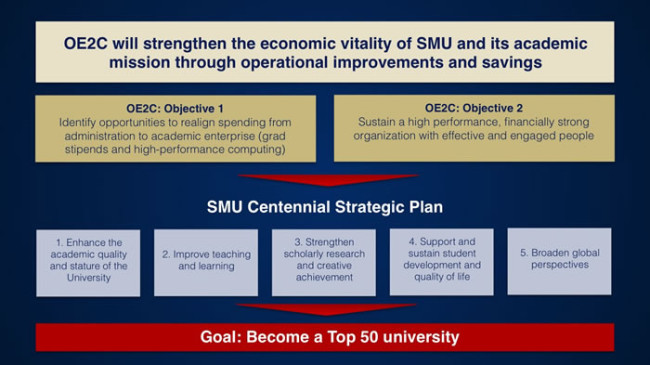*In an earlier version, the article noted that the athletic department could be receiving $2 million of funding, when in actuality the department could also be facing possible reductions. We regret the error.

Nearly five months after its launch, SMU’s Operational Excellence for the Second Century (OE2C) is beginning to transition into its second phase: developing solutions to raise the university’s profile across the country.
SMU, through its OE2C campaign, is seeking ways to become more efficient, increase productivity, reallocate sources from administration to academics, and slow the growth of tuition rates, which have been rising on campuses across the country.
Some of the specific solutions, which were presented at a faculty senate meeting this week, could include streamlining purchasing, centralizing information technology departments, using online software for travel planning and reimbursement, capping new hiring, and even shortening staff hours during the slower summer season.
The university hired Bain & Company earlier this year to help. The managing and consulting firm works with institutions, like SMU, to decrease excess costs and restructure operations in order to create sustainable changes and services.
“The deans met with the Bain team in the last few days, and there is almost unprecedented collaboration among deans for plans for the future,” Provost and Vice President for Academic Affairs Paul Ludden said at the meeting.
SMU officials working with the Bain team said that some of the changes to how the University operates could result in a savings of up to $30 million to $40 million. All departments around the university could be effected.

Marty Sweidel, Meadows associate dean, has been working with the Bain team all summer.
“We brought in consultants that we’re paying an awful lot of money to help us through this process,” Sweidel said. “It buys us time […] to be thoughtful about the solution.”
Sweidel and Bill Detwiler are co-coordinators of OE2C. The two showed a slideshow to faculty members and stressed that they would be thoughtful, transparent, collaborative and data-driven while making decisions.
Universities across the U.S. are facing problems like unsustainable tuition growth and unchecked university costs.
One of the most sensitive issues under consideration at SMU is possible staff cuts or reduction in staff hours.
Sweidel noted that SMU is in better shape than many universities so they can take a more thoughtful approach to shifting administrative costs to academics.
Possible solutions include not replacing people when they retire, shortening staff hours especially in the summer, allowing people to move to other openings, and consolidating some jobs.
“The desperate way of doing things is saying, ‘Yes, you’re right. We have too many people in administrative jobs than our cohorts,’” Sweidel said. “Firing will not fix anything and will lower morale even more.”
Another solution is the implementation of software to review travel expenses electronically. This would reduce the amount of paper moving back and forth across the university and, in turn, would free up staff time to be used on smarter, strategic things.
Four vendors presented their software solutions to faculty, staff and administrators this week. Sweidel stated that whatever software is bought will be useful and effective in meeting the university’s needs.
One of the major goals under OE2C is to reallocate administrative costs to academics. According to Detwiler, 65 percent of costs have gone to non-teaching and research and administrative overhead.
“There’s been this huge growth on administrative costs,” Detwiler said. “I think we need to get some of this 65 and move it over to the academic side.”








